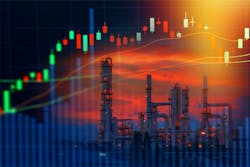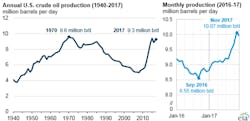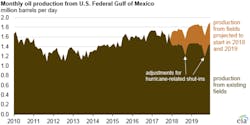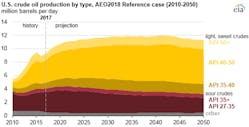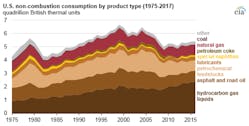US crude oil production on track for record 2018
After reaching 9.3 million barrels per day (b/d) in 2017, U.S. crude oil production is on track for a record-setting 2018, reported the U.S. Energy Information Administration (EIA). Production increased 464,000 b/d in 2017 after declining 551,000 b/d in 2016. Monthly production hit 10.07 million b/d in November 2017, breaking the record for the highest monthly level in U.S. history. The EIA expects U.S. crude oil production increases to continue in 2018 and 2019, averaging 11.3 million b/d by 2019. Production methods such as horizontal drilling and hydraulic fracturing have largely driven increases over the last 10 years.
Graphic courtesy of EIA
Record-high Gulf of Mexico production to continue
Despite platform outages and pipelines issues in December 2017, U.S. crude oil production in the Gulf of Mexico increased in 2017 to 1.65 million b/d, the highest annual level on record. The EIA predicts the levels to increase in 2018 and 2019 as well, accounting for 16 percent of U.S. crude oil production each year and reaching 1.8 million b/d in 2019. The agency also acknowledges that oil market uncertainty could affect long-term planning and operations in the region, which could impact future projects. Oil production in the Gulf of Mexico is less sensitive to short-term oil price movements than U.S. onshore production in the Lower 48 states.
Graphic courtesy of EIA
Summer gas prices expected to increase 11 percent
The EIA expects summer 2018 gas prices to cost an average of $2.74 per gallon, an 11-percent (or 26-cent) increase over summer 2017 prices. The amount is still 15 cents per gallon lower than the average price from 2013 to 2017, however. The EIA predicts that gas prices will average $2.64 per gallon in 2018 overall. While U.S. households on average will spend about 4.7 percent more on gasoline in 2018 than they did in 2017, they are expected to spend less than in 2014, when retail gasoline prices averaged more than $3.00 per gallon.
Graphic courtesy of EIA
Light, sweet crude to account for most of production growth
Light, sweet crude oil made up nearly 90 percent of crude oil production growth from 2010 to 2017. It accounted for 56 percent of domestic crude oil production in 2017. The EIA expects it will make up 60 percent by 2020 and 70 percent by 2050. Most of the growth of this type of oil will likely occur in the Gulf Coast, where it could grow from 3.1 million b/d in 2017 to 5.3 million b/d in 2050. Light, sweet crude oil has an API gravity of at least 35 and sulfur content of 0.3 percent or less.
Graphic courtesy of EIA
Natural gas storage design capacity increases while demonstrated peak decreases
The EIA reported that natural gas storage design capacity, or "the sum of the working gas capacity for all active facilities in the Lower 48 states" grew about 1 percent in 2017. Meanwhile, demonstrated peak (demonstrated maximum working gas volume) fell by 1 percent in the same year. Expansion in the East storage region drove the increase, where capacity grew by 2.7 percent.
Graphic courtesy of EIA
US uses about 7 percent of fossil fuels for noncombustion purposes
Noncombustion fossil fuel consumption accounted for about 7 percent of total fossil fuel consumption. Fossil fuels can be used but not combusted, in construction materials, chemical feedstocks, lubricants, solvents, waxes and more. The EIA estimated that if the amount had been combusted, 2017 carbon dioxide emissions would have been about 4 percent higher.
Graphic courtesy of EIA
